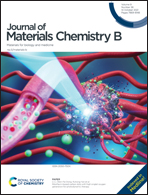An ultrasensitive chemiluminescent biosensor for tracing glutathione in human serum using BSA@AuNCs as a peroxidase-mimetic nanozyme on a luminol/artesunate system†
Abstract
In this work, a nanosensor chemiluminescent (CL) probe for sensing glutathione (GSH) was developed, for the first time, based on its inhibition of the intrinsic peroxidase-mimetic effect of BSA@AuNCs. The endoperoxide linkage of artesunate could be hydrolyzed by BSA@AuNCs resulting in the release of reactive oxygen species (ROS), and the consequent generation of strong CL emission. By virtue of the strong covalent interactions of –S⋯Au–, GSH could greatly suppress the peroxidase-mimetic effect of BSA@AuNCs, leading to a drastic CL quenching. The CL quenching efficiency increased proportionally to the logarithm of GSH concentration through the linearity range of 50.0–5000.0 nM with a limit of detection of 5.2 nM. This CL-based strategy for GSH tracing demonstrated the advantages of ultrasensitivity, high selectivity and simplicity. This strategy was successfully utilized to measure GSH levels in human serum with reasonable recovery results of 98.71%, 103.18%, and 101.68%, suggesting that this turn-off CL sensor is a promising candidate for GSH in biological and clinical samples.



 Please wait while we load your content...
Please wait while we load your content...